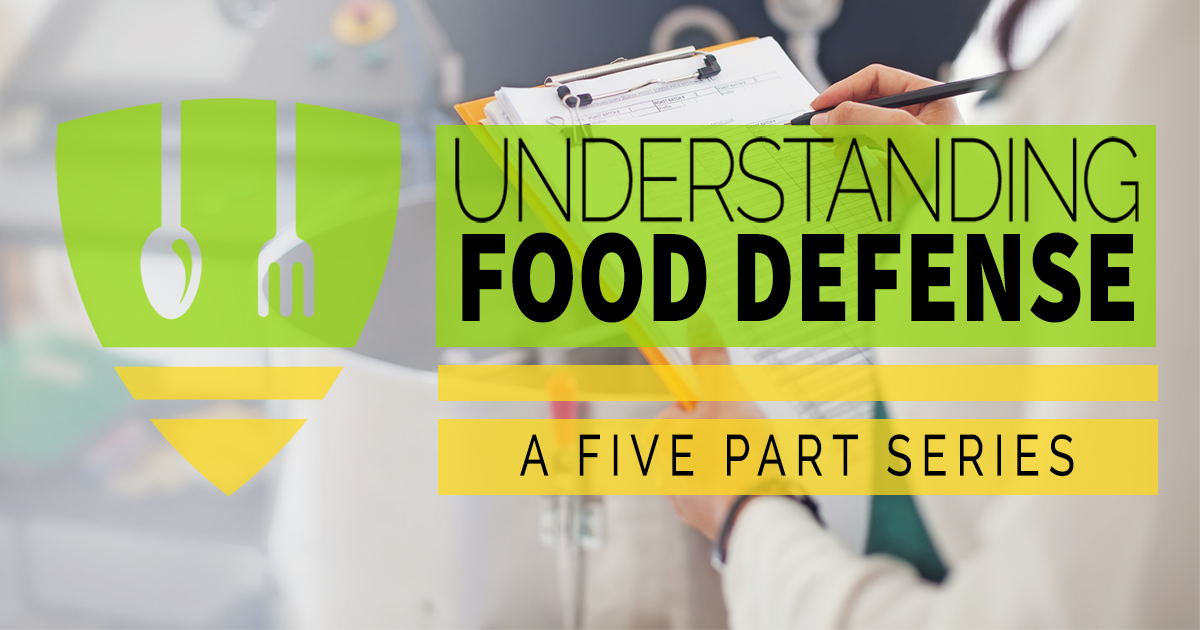Understanding Food Defense
Understanding Food Defense
Interpreting the Requirements of the new FSMA Food Defense RuleIf you find yourself confused about the new FDA food defense rule, you are not alone. Understanding food defense can be tricky since the definition has been revised by FDA to include acts of intentional adulteration. The title of the new rule itself does not mention food defense, and is called “Mitigation Strategies to Protect Food Against Intentional Adulteration”. Training to become a “qualified individual” in order to implement the above rule has been segregated into at least 4 different certification classes, which are defined and explained on FSPCA’s Intentional Adulteration website.
Most of the training is available online as a pre-recorded training, however, the Intentional Adulteration - Conducting Vulnerability Assessments course is an instructor-led course that many food industry professionals are seeking in order to better understand the first primary step in developing a food defense plan - conducting a vulnerability assessment.
Today’s blog post - “Understanding Food Defense” is the first in a 5 part series to help food safety professionals better understand the complicated and often confusing food defense plan process.

What is Food Defense?
Written Vulnerability Assessment
Companies begin with a written vulnerability assessment. This assessment pinpoints the process steps that pose a significant risk for successful intentional adulteration. These are called “Actionable Process Steps”. An example would be a liquid mixing step where a food product/ingredient is easily accessible and if a contaminant were added, would result in a wide-scale public health incident.
Mitigation Strategies for each Actionable Process Step
Based on significant vulnerabilities uncovered in the vulnerability assessment, the company must then put in place preventive or mitigating measures at each of these actionable process steps. For instance, in our example above, the process step would likely be considered a significant vulnerability and the company would then put in place an appropriate mitigation strategy, such as reducing the accessibility of the product at the mixing step.
Monitoring Mitigation Strategies
Once the significant vulnerabilities have been identified, and mitigation strategies are in place, the company must next create a monitoring and verification framework to ensure those mitigation measures are properly implemented. If any strategies are found to be improperly implemented or deemed ineffective, then corrective action must be taken to correct the situation. All employees who have responsibilities at actionable process steps must be trained and qualified to perform those activities and are also required to take food defense awareness training. All training must be documented to include the type of training, date of training and the persons trained.
Food Defense Plan Preparation and Reanalysis
A qualified individual must also be responsible for the overall preparation and reanalysis of the food defense plan. Reanalysis of the plan must be performed at least every 3 years, unless there is a significant change in a facility that would introduce a new vulnerability or increase the risk of an already identified vulnerability. A reanalysis would also need to be performed if new vulnerabilities are identified with a food operation or facility, when mitigations strategies or food defense plan as a whole is not properly implemented or if FDA requires reanalysis to respond to a new vulnerability or other credible threats to the food supply.
What is Intentional Adulteration?
Intentional adulteration is the act of a person or group of people intentionally doing something that will cause an acute illness or death on a mass scale in a food manufacturing facility.
The goal of food defense is to prevent a person or group of people from successfully accessing and tampering with the food chain, averting a wide-scale public health incident. Companies are required to develop and implement a food-defense plan by focusing on vulnerabilities within the plant. Steps must then be taken to prevent or minimize these dangers. That might mean simply closing an open hatch, or something more complex like changes in staffing so that areas aren’t left unattended. The Mitigation Strategies to Protect Food Against Intentional Adulteration focuses more on several key areas that present possible vulnerabilities in the food production and preparation process – including mixing and ingredient-adding/staging areas, bulk liquid loading and receiving, and bulk liquid storage and holding areas. These are known as Key Activity Types (KAT’s).
FDA’s Requirements for Creating Food Defense Plans
FSPCA’s Food Defense Training vs Other FSPCA Training
The Food Safety Preventive Controls Alliance (FSPCA) is a broad-based public private alliance consisting of industry, academic, and government stakeholders. Part of their mission is to help food companies with understanding food defense. They develop curricula, training and outreach programs to support compliance with the prevention-oriented standards of the Food Safety Modernization Act (FSMA). What’s different about their food defense curriculum as compared to other FSPCA curricula is that food defense training is divided into multiple classes.
Those classes include:
Food Defense Awareness
Individuals who are assigned to work or have responsibilities at actionable process steps, as well as their supervisors, are required to receive training in food defense awareness. Those individuals can meet this training need by taking the “”Food Defense Awareness for the Intentional Adulteration Rule” online training course provided by FSPCA.
Overview of the Intentional Adulteration Rule
This course solves an important part of understanding food defense by giving participants an overview of the Mitigation Strategies to Protect Food from Intentional Adulteration rule. This training is not required but is helpful for those who want a high level overview of the components required for a compliant food defense plan.
Conducting Vulnerability Assessments Using the KAT (Key Activity Types)
This training course discusses the different food processes that FDA recognizes as frequently vulnerable to intention adulteration, known as the KAT(Key Activity Types). This is a fairly simplified vulnerability assessment method which allows a qualified individual to quickly identify those key activity types in their facility and assign mitigation strategies to each of those steps without further evaluation.
Conducting Vulnerability Assessments Using the Three Fundamental Elements
This is the instructor-led training course that teaches individuals how to perform a more in-depth vulnerability assessment than the previously mentioned KAT method. This method can also blend the KAT and three elements together to form a hybrid vulnerability assessment.
Identification and Explanation of Mitigation Strategies
Significant vulnerabilities identified through proper vulnerability assessments will need to have mitigation strategies in place in order to prevent future intentional adulteration occurrences. Explanations for why certain steps and/or processes have been identified as actionable process steps will need to be documented.
Food Defense Plan Preparation and Reanalysis
This training course covers the basics of how to prepare and organize the food defense plan as well as the requirements for reanalysis. Those individuals who are responsible for organizing the plan and reanalyzing it at least every 3 years would become a qualified individual to perform these tasks by taking this course.
Understanding Food Defense - The First Step
About the author

Lance Roberie
Food Safety Consultant and TrainerLance Roberie has over 20 years of quality assurance and food safety experience within the food industry. Mr. Roberie holds the following certifications:
- Certified Food Safety HACCP Manager
- Preventative Controls for Human Foods (PCQI) Lead Instructor
- Meat & Poultry and Seafood HACCP Lead Instructor
- FSPCA Food Defense (IAVA) Lead Instructor
- ASQ Certified Manager of Quality & Organizational Excellence
- ServSafe Instructor and Exam Proctor
- Internal Auditor and GFSI Specialist
Lance and the Food Safety & Quality Services’ training curriculum will advance your team's food safety knowledge through certified training, consulting, and “real life” industry scenarios.
upcoming Classes
June 13, 2024 09:00 AM - 04:00 PM
June 11, 2024 08:00 AM - June 12, 2024 04:00 PM
June 18, 2024 08:00 AM - June 19, 2024 04:00 PM
Need a Food Safety Specialist?
Free 15 Minute Consultation.Learn how we helped Abita Brewing Company pass their first food safety audit with an A grade.

